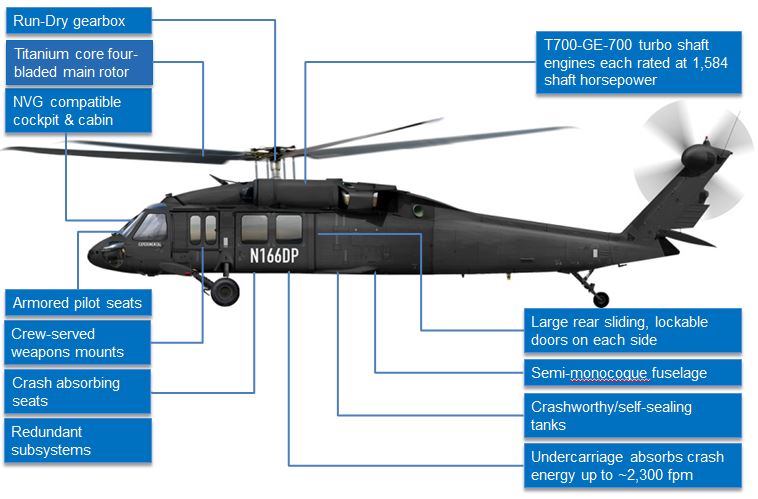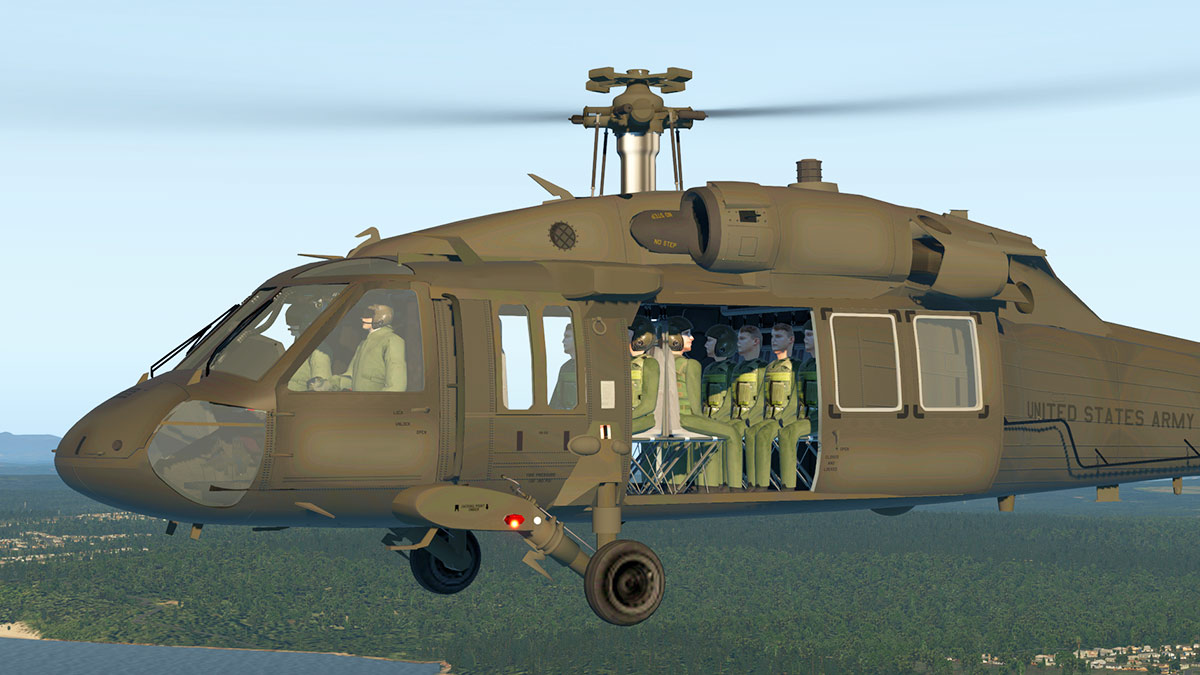Find Out About the Versatility of the UH-60 Blackhawk
The UH-60 Blackhawk is an impressive instance of modern military engineering, symbolizing adaptability throughout a vast array of operational contexts. From troop transport to medical evacuation and reconnaissance missions, its style fits different duties while stressing quick release and flexibility. The innovative avionics and durable capacities of the Blackhawk not just boost its functional effectiveness in challenging environments but also prolong its utility in humanitarian efforts. Comprehending its multifaceted applications motivates a closer assessment of just how this helicopter proceeds to develop and influence private and armed forces operations alike.
History of the UH-60 Blackhawk
The UH-60 Blackhawk, a functional utility helicopter, was developed in the late 1970s by Sikorsky Airplane to meet the united state Army's demand for a modern-day tactical transport helicopter. This campaign occurred in response to the constraints observed in the previous generation of helicopters during the Vietnam Battle. The U.S. Military sought an aircraft that might carry out a variety of goals, including army transport, clinical evacuation, and logistical assistance, while also showing enhanced survivability and efficiency.
The Blackhawk was developed with advanced innovation and engineering, featuring a twin-engine configuration, a four-bladed rotor system, and a robust airframe. Its initial flight happened in 1974, and it was formally presented right into service in 1979, rapidly ending up being a pivotal possession for the united state military. The helicopter's versatility allowed it to be used in numerous combat and humanitarian procedures, showcasing its effectiveness in diverse atmospheres and missions.
Over the decades, the UH-60 has actually undertaken continuous upgrades and alterations, guaranteeing its significance in modern warfare. Its heritage has actually strengthened its status as a cornerstone of armed forces air travel, mirroring a commitment to development and functional quality.
Key Functions and Specs
Regularly admired for its design expertise, the UH-60 Blackhawk flaunts a series of key functions and specs that improve its operational capabilities. This versatile helicopter is powered by two General Electric T700-GE-701C engines, each capable of producing 1,800 shaft horse power, enabling it to attain a maximum cruise rate of about 150 knots.
The airplane's distinct design consists of a four-blade primary rotor system and a four-blade tail rotor, adding to remarkable ability to move and security. With an optimum launch weight of 22,000 extra pounds, the UH-60 can carry up to 11 soldiers or equivalent freight. Its innovative avionics collection supplies improved situational understanding and navigating, important for various mission profiles.
The Blackhawk features a durable airframe built from sophisticated composite products, using increased longevity and resistance to little arms fire. UH-60 Blackhawk. In addition, the helicopter is equipped with an electronic fly-by-wire control system, improving responsiveness and minimizing pilot work. With a series of about 600 maritime miles and the capacity to run in diverse environments, the UH-60 Blackhawk continues to be a critical asset in modern army operations
Armed Force Applications
With its innovative attributes and specs, the UH-60 Blackhawk has come to be a cornerstone of military procedures across the world. Designed for flexibility, it fulfills a vast range of functions ranging from army transport to clinical emptying. The helicopter's capability to operate in varied environments-- whether in battle zone or challenging surfaces-- ensures it stays an essential asset for modern-day military pressures.
The UH-60's robust design enables the transport of as much as 11 soldiers, sustaining rapid release during important missions. Its innovative avionics and navigating systems improve situational awareness, allowing pilots to perform intricate operations even in adverse climate condition. Additionally, the helicopter is equipped with defensive systems to shield against dangers, ensuring the security of personnel onboard.

Altruist Objectives

Altruistic objectives often depend on the UH-60 Blackhawk for its unmatched convenience and rapid feedback capabilities. This multi-role helicopter has confirmed indispensable in various situations, consisting of disaster relief, clinical discharges, and logistics support in remote or hard to reach locations - UH-60 Blackhawk. Its capability to carry employees and products swiftly enables timely treatments throughout situations, considerably enhancing the performance of humanitarian operations
The Blackhawk's sophisticated avionics and durable design allow it to operate in difficult settings, such as damaging weather condition problems or tough surfaces. Outfitted with raising systems and clinical helpful site emptying capacities, the helicopter can get damaged people from hard-to-reach locations, guaranteeing timely medical attention. Additionally, its ability to rapidly deploy aid supplies, consisting of food, water, and important equipment, makes it an important possession in massive relief efforts.
Moreover, the UH-60 Blackhawk's versatility enables different setups tailored to specific goal demands, whether it involves transferring emergency -responders or supplying crucial resources to affected populaces. Its functional history in humanitarian goals highlights the aircraft's crucial role in easing and conserving lives suffering during all-natural catastrophes and humanitarian crises, showcasing its withstanding commitment to sustaining worldwide relief initiatives.
Future of the Blackhawk
The future of the UH-60 Blackhawk appears promising as Read Full Report advancements in technology and advancing objective requirements form its ongoing relevance in army and private procedures. As armed forces around the globe seek to modernize their fleets, the Blackhawk is undertaking upgrades that boost its capacities, consisting of improved avionics, progressed interaction systems, and boosted haul abilities.
The assimilation of unmanned systems and expert system is positioned to revolutionize operations. Future versions may include autonomous flight capacities, permitting boosted operational versatility and lowered risk to personnel during high-threat goals. Additionally, hybrid-electric propulsion systems are being checked out to boost fuel effectiveness and minimize the ecological footprint of armed forces procedures.
International collaborations and export opportunities are likewise increasing the Blackhawk's worldwide impact. As countries purchase modernizing their air flexibility capabilities, the Blackhawk's convenience makes it a favorable choice for different functions, from army transportation to clinical evacuation and search-and-rescue operations.
Conclusion
The UH-60 Blackhawk exemplifies adaptability in armed forces aeronautics, properly meeting duties varying from army transportation to clinical emptying and reconnaissance. visite site Its sophisticated innovation and versatility allow successful operations in varied settings and objective situations. The airplane's contributions prolong beyond armed forces applications, playing a substantial duty in altruistic efforts and disaster response. As operational needs advance, the ongoing advancement and integration of the Blackhawk will certainly guarantee its relevance and effectiveness in resolving future difficulties in both armed forces and civilian contexts.

With its sophisticated attributes and requirements, the UH-60 Blackhawk has actually come to be a keystone of army procedures throughout the world. As army approaches advance, the UH-60 Blackhawk proceeds to play an essential duty in boosting functional efficiency and making sure objective success throughout the cinemas of interaction.
Humanitarian goals typically depend on the UH-60 Blackhawk for its unequaled adaptability and fast reaction capabilities. UH-60 Blackhawk.The UH-60 Blackhawk exhibits convenience in armed forces air travel, efficiently fulfilling duties varying from troop transportation to clinical emptying and reconnaissance